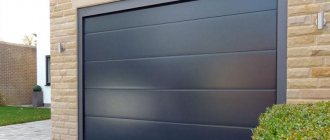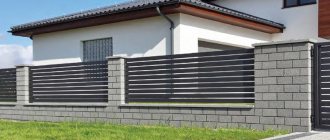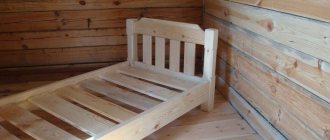Every dacha owner wants the gate on his property to be not only functional, but also not too expensive, and also beautiful. The most convenient option that can satisfy all these requirements is a wooden gate. Moreover, there is no material that can be processed more easily. A simple task is to make a wooden gate with your own hands.
An example of a simple homemade gate made of wood and profile pipes
Return to contents
Selection of material for the gate
When we are faced with the problem of choosing a material for a gate, we are primarily guided by two criteria: price and durability. Of course, wood cannot be compared with metal in terms of strength, but in terms of cost it wins.
Finishing and painting a wooden gate to look like metal
And this material combines with the overall design of the site just wonderfully.
Return to contents
Softwood
If we talk about wood species, then everything depends on the capabilities and taste of the owner of the dacha. Of the coniferous species, pine is considered the most accessible and cheapest material. It is easy to process and withstands the vicissitudes of the weather well due to its high saturation with resin. In addition, the pine board has a beautiful golden color and if you open it with varnish, you will get a wonderful gate made by yourself.
Larch is much stronger than pine, it has an excellent structure and is remarkably easy to process. But its cost is also slightly higher. Therefore, the use of this type of wood is not very practical for the manufacture of wickets and gates. Cedar is much more expensive than pine, although in some respects it is even slightly inferior to it. This wood is famous for its high resistance to cracking and rotting.
Original decor of a wooden gate with forged elements and pillars made of natural stone
Cedar will make a wonderful carved gate, because it is the best species for this type of processing.
Return to contents
Hardwood
Oak will undoubtedly be the best option when making an inexpensive garden gate. This is a common type of wood, which is famous not only for the beauty of its structure and expressive color, but also for its strength and resistance to bad weather. This is hard wood, which is more difficult to process, but a wooden oak gate will last for many years without losing its beauty and strength.
Aspen is almost as good as oak, but is used extremely rarely for fencing. Easy to process, does not warp or crack.
Poplar can be used to make wooden gates. But if the board is damp, it is more susceptible to deformation than other types of wood. Therefore, you need to buy only well-dried material, or before use, lay it out on a flat surface and let it dry.
An example of a gate made of aspen and metal corners
Birch is a very affordable material, but its quality is significantly inferior to other types of wood. It is more susceptible to cracking. In the absence of another option, you can make a gate from birch, but its service life will not be too long.
Return to contents
Variety in design and materials
Before you make a wooden gate or gate with your own hands, you need to know the types and features of their designs. After all, their strength and durability depend on this.
Based on the type of material, wickets are divided into two types:
- Wooden, when the frame and canvas are made entirely of wood;
- Combined, when the gate frame is made of metal corners or corrugated sheets, and the cladding is made of any type of wood.
Depending on the appearance, gates can be divided into the following:
- A blind gate, with continuous cladding, without gaps between the pickets;
- Through or lattice gates are beautiful wooden gates in which the cladding is made with uniform gaps. Through such a gate you can easily see the dacha courtyard. They are more often installed to separate zones on the site than at the entrance.
The design is of great importance for the durability and functionality of the gate. A durable gate with a rigid frame will not warp over time and will serve well for many years. According to the design features, wickets and gates can be divided into the following types:
- Wooden gates without struts: the top plank of the cladding is flat;
- Wickets with a strut: the pickets in the upper part have a cut from the center of the sheathing to the trim rails. This makes the frame stronger and more rigid.
Return to contents
How to make a gate with your own hands
A wooden gate can be made in several ways.
Diagram of the gate design with dimensions for self-production
At the dacha, a gate can have different purposes, and depending on this, its appearance and method of construction are determined. Regardless of the design, work on creating any wooden wicket or gate begins with the preparation of working tools and building materials. Wet wood must dry out, and for this to happen correctly, it is necessary to provide a smooth surface and ventilation.
At the same time, direct sunlight should not be allowed to hit the material, as this will negatively affect the quality of the future gate. It is best to purchase ready-made planed boards of the same thickness. But you can save money by cutting them yourself.
Return to contents
Wicket with frame
If you want to make a gate with your own hands, then this is the easiest and fastest way. The basis of such a product is a frame on which slats or sheathing boards are stuffed. So, we take slats with a cross-section of at least 5 cm and install the base. It can have different shapes - z-shaped, hourglass, triangle, diamond - the main thing is to ensure the strength of the gate. It all depends on your imagination. But any of these forms has an upper and lower crossbar.
On a flat surface, you need to lay out the crossbars parallel to each other at the required distance. This value depends on the height of the gate. Typically, the crossbars are located 20–25 cm from the top and bottom edges of the gate leaf. After this, the struts are placed in a certain shape. Once everything is accurately measured, the strut strip is cut to the required length with precise angles. The struts are fastened with long screws or nails. After the base of the gate is made, you can begin installing the sheathing.
Preliminary laying out of gate slats for subsequent assembly
It can be made solid or with gaps. For this, boards, picket fences or slats of the same length and cross-section are used. Combined gates look very nice, where the bottom is completely sewn, and the top is openwork, with gaps. The top of the gate can be made flat or sloped.
To do this, draw a rounded top or an angle from the center to the edges on the sheathing with a pencil and cut it out using a jigsaw or handsaw.
There are many options for the appearance of such gates. A solid sheathing can be decorated with a pattern of narrow slats, stuffed at an angle in the form of diamonds. It can be one-sided or two-sided, when the frame is hidden between two identical sheathing sheets. In addition, you can make a welded frame of the gate, from a metal corner or profile. But then it will no longer be a wooden gate, but a combined one.
Return to contents
Frame gates
A wooden gate can have a frame in the form of a frame.
In this embodiment, the support and cover trims are connected by an upper and lower transverse rail. A rectangular frame in the form of a frame can be fastened with a groove connection, when there is a hole in one part of the frame and a groove of the required size on the other.
Wood glue is used for strength. Before gluing the frame structure, you need to check the correctness of the angles, because even a small misalignment will lead to rapid failure of the gate. The fastening element of the frame slats are long screws or nails. The pin connection will be no less durable and very neat. To do this, holes are turned at right angles on two slats at the junction, into which a wooden pin is driven with a wooden hammer.
Wooden gate assembly process
With this method, the bottom strip and the two sides of the frame are first fastened together. The next step is to prepare the holes in the bottom rail, as well as in the sheathing parts. Pins are inserted into the finished holes of the frame, which can be additionally lubricated with wood glue. Picket fences or sheathing boards are placed on them by lightly tapping with a wooden hammer.
The final stage of construction is to fasten the structure with the upper frame bar in the same way. Wooden gates and gates with a frame frame can be made in a wide variety of designs. You can combine two types of sheathing, connecting the board end-to-end at the bottom and with gaps at the top.
Making a gate of a complex design with your own hands is not so easy, but if you arm yourself with patience, use your imagination and use all the knowledge and experience accumulated over the years, you can create a real decoration for your dacha or yard.
Unusual designs of wooden gates
Return to contents
Peculiarities
It is unnecessary to talk about the functional significance of the gate without mentioning the importance of the fence itself. After all, it all starts with him. The strength and reliability of the gate and fencing eliminates the possibility of uninvited guests entering the private territory, and also ensures sound sleep for the owners and confidence in the safety of property.
When planning a fence, you need to determine and decide where and how the gate door will be installed. Sometimes homeowners decide to build the fence themselves. In this case, it would be best to do the same with installing a wicket entrance. Some plot areas allow owners to install two gates at once: one for the main entrance, the other for various household needs.
Read also: How much does a listening device cost?
To make the gate, the same material is used that is used to install the entire fence. If this is not the case, it is important to consider the compatibility of these two (or more) materials so that no problems arise during installation.
The standard width of the product is usually at least a meter. This is the optimal size of the opening, which, if necessary, will allow you to bring large items or furniture inside. The height of the wicket product, according to the requirements of SNiP, should not exceed the maximum height of the fence - 2 m 20 cm.
The optimal depth for fence posts is 1 m. It depends on the type of base. Sometimes you can limit yourself to 70 cm. If a heavy soil layer predominates on the site, it is necessary that the pillars be installed below the freezing point.
Sometimes owners have to terracing the dirt strip under the fence in order to even out differences in height between sections, unevenness, and also eliminate gaps that provide a chance for uninvited guests with four paws to get into the yard.
The handle and lock of the gate are usually located at a level of 90 cm from the ground. However, even minor flaws in the placement of these elements will not affect their functional value.
One of the inventions and innovations of our time is the automatic gate.
Opening and closing of the product occurs using automatic means, and also includes a number of advantages:
- Remote control. The gate is opened and closed even when the homeowner is at a considerable distance from the entrance.
- Increased security. In combination with other elements of the security system (video surveillance cameras, intercom), it makes it possible to find out and establish the identity of the person who comes remotely, as well as decide whether to open the door gate or not, without leaving the house.
- Save time. The automatic gate opens by pressing just one button.
- Strength of the material. Wickets with an automatic function can be made of high-strength material.
This is just a small list of the advantages of an automatic product from a huge list. However, just like in its functionality, the price of this purchase also differs significantly from simpler and standard options.
In this article we will look at options for decorating a gate yourself and make sure that it is not so difficult, especially since creativity and creativity take place in the process of performing this work.
Correct installation of the gate
There is nothing complicated in installing a gate, and you can do it yourself. The main thing that affects the quality of installation and functionality of the gate is the reliability of the posts and the correct selection of hinged hinges.
Typically, the location for the gate is determined at the initial stage of installing the fence. If we are talking about replacing an old gate with a new entrance door, and the pillars are already in place, the new product is simply hung in place of the old gate.
The most durable poles for these purposes will be metal poles. It is better to make wooden supports from oak, as it is considered the most resistant wood to the influence of the external environment. The depth of the pit for supports depends on the type of soil and the degree of freezing in winter.
Preparing concreting for gate posts using the example of a metal gate
This must be especially taken into account if the pillars will be concreted. You also need to take into account the height of the gate, because the posts for a meter-high gate do not need to be dug to a meter depth, 60–70 cm is enough. The gates are hung on swing hinges, which allow it to open in one direction. When choosing, you need to calculate how much weight they will have to withstand. The more massive the gate, the more reliable the hinges - this is the principle.
The prepared loops are screwed with self-tapping screws to the upper and lower trim strips. After this, you need to mark the place where the hinges are attached to the support post. The gate is installed vertically in the opening, taking into account the distance to ground level, and the canopies are attached to the pole. They are attached to metal posts by welding.
Return to contents
The first stage - installation of supports
After marking the ground during the preparation process, holes are dug for the supports. Pre-purchased pipes for support pillars must lie in the ground 1/3 of the total length (must be provided for in the drawing). The pipes are treated with an anti-corrosion solution and leveled in the pit using a building level. The pits are filled with crushed stone and concreted with a solution of sand and cement in a ratio of 3:1.
On this topic:
Homemade mousetraps from a plastic bottle - two...
DIY refrigerator incubator: two simple models...
How to improve a summer cottage with your own hands (photo)
Do-it-yourself beds made from plastic panels are easy to...
BACK FORWARD 1 of 43
After pouring, do not press on the pillars for several days.
After hardening, loops are welded to the pipes. Priming and painting are in progress.











